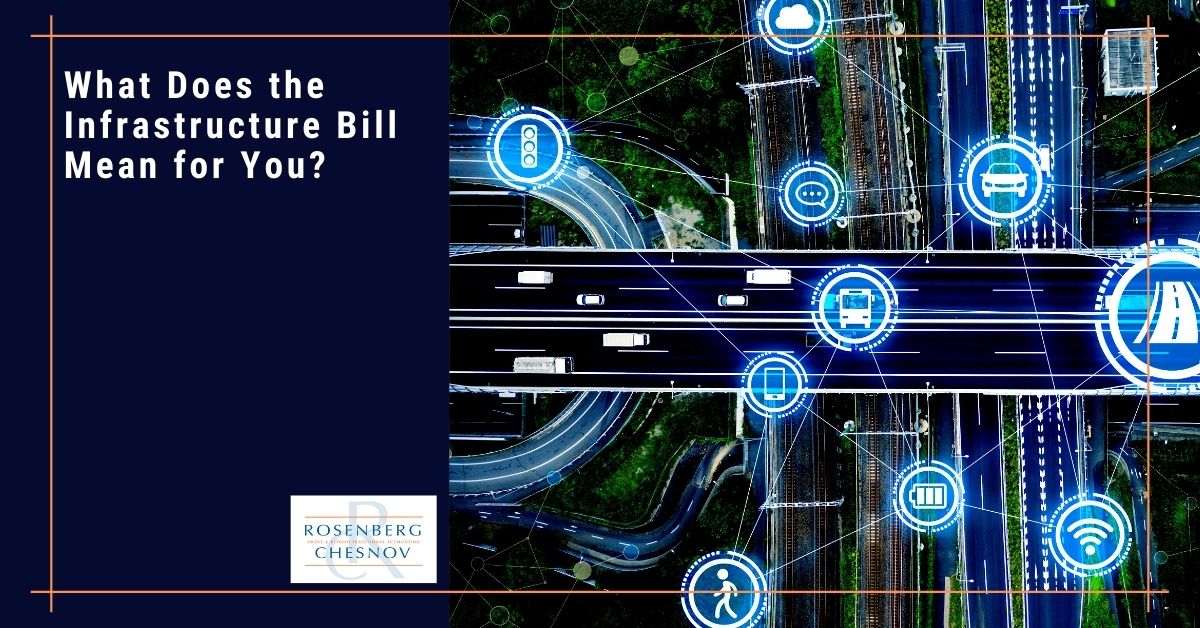What’s in the infrastructure bill?
Of the total $1.2 trillion, $550 billion represents new spending, which will go towards what’s called “hard infrastructure.” This refers to physical or built infrastructure, such as roads, bridges, tunnels, railways, airports, seaports, power networks, water management, etc.
(“Soft infrastructure,” refers to the services, systems, and institutions required to maintain quality of life. This encompasses government, health, education, financial and legal systems, law enforcement, emergency services, and more.)
The remaining funding included in the bill, approximately $650 billion, covers spending which Congress has previously authorized, such as federal highway, transit, and safety programs, rail programs, and public transit over the next five years.
So how does the new spending break down?
Let’s start with the big-ticket item:
$110 billion for roads, bridges, and major projects
The bill allocates this money to the nation’s roads and bridges. It increases funding for major project grant programs and construction, repair, and research.
Further, this section contains the Surface Transportation Reauthorization Act, which provides $303.5 billion over five years for federal highway programs, a 35% increase.
At the same time, it preserves The Highway Funding Formula, which apportions 90% of federal highway assistance to states based on performance and equity-related metrics.
The second largest investment included in the bill is:
$73 billion to upgrade the nation’s electric power grid
By modernizing the electricity grid and adding miles of new transmission lines, this section of the bill will allow the grid to carry more renewable energy.
Also included are investments into clean-energy projects, electric vehicle charging stations across the country, and funds to create a new federal entity within the Energy Department called the Grid Deployment Authority, which will develop high-voltage transmission lines.
Taken together, this section represents the most significant investment into power transmission in the history of the U.S. federal government.
The legislation also represents the largest investment into passenger rail by earmarking:
$66 billion for passenger and freight rail
This significant investment will fund high-speed rail, safety improvements, $22 billion in grants to offset Amtrak’s maintenance backlog, and $24 billion towards the modernization of the Northeast Corridor rail route, which connects Washington, D.C., to Boston.
Additionally, the new law will expand internet access for hard-to-reach populations by investing:
$65 billion to expand broadband
This spending will build new broadband infrastructure across the country and provide grants, low-cost plans, and subsidies to help low-income households and rural and tribal communities access the internet.
What else is in the bipartisan infrastructure bill?
In addition to the above, the new law also includes the following:
- $55 billion towards water infrastructure to replace lead pipes and protect the water system against climate change and cyber attacks
- $39 billion to modernize and repair public transit while improving access for the elderly and the disabled
- $25 billion to upgrade, repair, and expand U.S. airports and control towers, and reduce emissions and project backlogs
- $17 billion to modernize and repair seaports while reducing emission and easing supply chain congestion
- $21 billion to clean up abandoned mines, contaminated waterways, and other polluted sites and to restore the Great Lakes
- $47 billion to combat wildfires and improve climate resiliency in coastal areas
As mentioned, this new law is sweeping and complex, and these summaries only scratch the surface of the impacts it will have. Nevertheless, let’s turn now to another important question.
What are the tax implications of the infrastructure bill?
Let’s start with the good news: the infrastructure bill does not raise taxes. That said, however, there are some tax provisions included in the bill that you may want to be aware of.
Early termination of the Employee Retention Tax Credit
Introduced as part of the Coronavirus Aid, Relief, and Economic Security Act (CARES) in March of 2020, the Employee Retention Credit (ERC) was a refundable credit that businesses could claim on qualified wages paid to employees. The intention was to provide relief to business owners by helping them retain their workforces. The tax credit was available quarterly, with the American Rescue Plan (signed in March of 2021) extending into the third and fourth quarters of 2021.
However, to help pay for the infrastructure bill, the fourth quarter extension is now repealed, and the ERC has been retroactively terminated, effective October 1st, 2021. That means wages paid after that date are ineligible for the Employee Retention Tax Credit, except for wages paid by an eligible recovery startup business.
If you are a previously eligible employer and plan on taking advantage of this credit in the fourth quarter or 2021, you will need to make some adjustments. You’ll have to coordinate with your payroll vendors, and you may need to make amendments to Form 941 and make changes to your accrual accounting.
New requirements on cryptocurrency exchanges
As I discussed in this recent blog entry, another new provision of the infrastructure law helps fund the new spending by increasing tax compliance among cryptocurrency traders.
The new rule expands the definition of the word “broker” to include digital asset traders, thus requiring them to report the names, addresses, and gross proceeds associated with their transactions. That means that cryptocurrency traders will no longer be able to avoid certain tax consequences.
It’s worth noting that this part of the bill does not take effect until January of 2024 and is likely to be contested in Congress and the courts. Nevertheless, transparency is the best policy in the meantime. Crypto investors should keep careful and accurate records of their cost basis (what they originally paid for the asset) and consult a tax professional to ensure you’ve covered the bases.
Extension of pension plan interest rate “smoothing”
Finally, the infrastructure bill modifies and extends “pension-smoothing” policies in the American Rescue Plan Act.
Essentially a budgeting gimmick, pension-smoothing has been used in the past to help pay for things like infrastructure. The provision allows companies that sponsor pension plans to delay making pension contributions and reroute the money elsewhere within the company. Yet, because the pension payments would have been tax-deductible, it also generates more tax revenue for the government in the short term.
Ultimately, the company will still owe money to retirees, and therefore Congress does not fundamentally raise any new money with this tactic. When it comes to Congressional budgeting, however, merely creating the brief appearance of a tax increase is enough to fund new projects.
As I mentioned, this isn’t new, and the infrastructure bill does not significantly change existing policy. The new law adjusts the funding stabilization percentages enacted by the American Rescue Plan and extends the interest rate stabilization period from 2029 to 2034.
In closing…
This legislation is extensive and involved, and it may take years to understand the full impact. Until then, these key highlights and tax implications will help you know what to expect.
As always, we stand ready to support you with expertise and trusted counsel.
Would you like some help?
If you are a client and would like to book a consultation, call us at +1 (212) 382-3939 or contact us here to set up a time.
If you aren’t a client, why not? We can take care of your accounting, bookkeeping, tax, and CFO needs so that you don’t have to worry about any of them. Interested? Contact us here to set up a no-obligation consultation.
Stay informed
Interested in receiving updates in your mailbox? Check out our newsletter, full of information you can use. It comes out once every two weeks, and you can register for it below.





